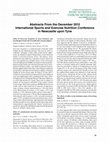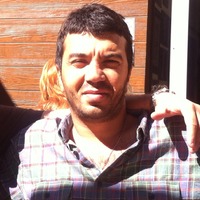Conference Presentations by Veeraj Goyaram

Several studies have shown that skeletal-muscle GLUT4 expression is increased by exercise and dec... more Several studies have shown that skeletal-muscle GLUT4 expression is increased by exercise and decreased by high fructose
consumption. While it is known that exercise enhances GLUT4
expression via increased binding of MEF2A to the GLUT4
promoter, the mechanism responsible for, and the impact of
fructose consumption on, this interaction have not been studied.
This study tested the hypothesis that both excess fructose and
exercise alter the accessibility of the MEF2 binding element on
the GLUT4 promoter by remodeling chromatin in the region.
Male rats (N = 30) were fed (a) standard chow, (b) chow + 10%
fructose drink, and (c) chow + 10% maltodextrin drink. All rats
had access to water and chow ad libitumfor a period of 13 days.
In the last 6 days of the experiment 5 animals in each group
performed 3 × 17-min bouts of intermittent swimming daily and
the remaining 5 remained unexercised. Triceps muscles were
harvested and used (a) for measurement of GLUT4 content by
Western blot, (b) to obtain intact nuclei for assessment of the
accessibility of the DNA region surrounding the MEF2 element
by nuclease accessibility assays, and (c) to measure the acetylation state of histones and bound MEF2A at the region by ChIP
assays. Serum glucose, insulin, and free fatty acids were also
assayed. Fructose did not alter GLUT4 content in untrained
rats but blocked the increase (~70%; p < .05) that occurred
due to swimming. Accessibility of the region surrounding the
MEF2 element by both MNase and DNase I was significantly
increased (~2-fold) by swimming only in rats that did not consume fructose. MEF2 binding and GLUT4 expression paralleled
the accessibility pattern. Maltodextrin had similar effects as
fructose. The mechanism by which fructose blocked chromatin
remodeling that occurs in response to swimming is not known
but may reflect differences in caloric intake or muscle fatty-acid
content. These effects are not unique to fructose.
Papers by Veeraj Goyaram

Contractile activity during physical exercise induces an increase in GLUT4 expression in skeletal... more Contractile activity during physical exercise induces an increase in GLUT4 expression in skeletal muscle, helping to improve glucose transport capacity and insulin sensitivity. An important mechanism by which exercise upregulates GLUT4 is through the activation of Ca2+/calmodulin-dependent protein kinase II (CaMKII) in response to elevated levels of cytosolic Ca2+ during muscle contraction. This review discusses the mechanism by which Ca2+ activates CaMKII, explains research techniques currently used to alter CaMK activity in cells, and highlights various exercise models and pharmacological agents that have been used to provide evidence that CaMKII plays an important role in regulating GLUT4 expression. With regard to transcriptional mechanisms, the key research studies that identified myocyte enhancer factor 2 (MEF2) and GLUT4 enhancer factor as the major transcription factors regulating glut4 gene expression, together with their binding domains, are underlined. Experimental evidence showing that CaMK activation induces hyperacetylation of histones in the vicinity of the MEF2 domain and increases MEF2 binding to its cis element to influence MEF2-dependent Glut4 gene expression are also given along with data suggesting that p300 might be involved in acetylating histones on the Glut4 gene. Finally, an appraisal of the roles of other calcium- and non-calcium-dependent mechanisms, including the major HDAC kinases in GLUT4 expression, is also given.










Uploads
Conference Presentations by Veeraj Goyaram
consumption. While it is known that exercise enhances GLUT4
expression via increased binding of MEF2A to the GLUT4
promoter, the mechanism responsible for, and the impact of
fructose consumption on, this interaction have not been studied.
This study tested the hypothesis that both excess fructose and
exercise alter the accessibility of the MEF2 binding element on
the GLUT4 promoter by remodeling chromatin in the region.
Male rats (N = 30) were fed (a) standard chow, (b) chow + 10%
fructose drink, and (c) chow + 10% maltodextrin drink. All rats
had access to water and chow ad libitumfor a period of 13 days.
In the last 6 days of the experiment 5 animals in each group
performed 3 × 17-min bouts of intermittent swimming daily and
the remaining 5 remained unexercised. Triceps muscles were
harvested and used (a) for measurement of GLUT4 content by
Western blot, (b) to obtain intact nuclei for assessment of the
accessibility of the DNA region surrounding the MEF2 element
by nuclease accessibility assays, and (c) to measure the acetylation state of histones and bound MEF2A at the region by ChIP
assays. Serum glucose, insulin, and free fatty acids were also
assayed. Fructose did not alter GLUT4 content in untrained
rats but blocked the increase (~70%; p < .05) that occurred
due to swimming. Accessibility of the region surrounding the
MEF2 element by both MNase and DNase I was significantly
increased (~2-fold) by swimming only in rats that did not consume fructose. MEF2 binding and GLUT4 expression paralleled
the accessibility pattern. Maltodextrin had similar effects as
fructose. The mechanism by which fructose blocked chromatin
remodeling that occurs in response to swimming is not known
but may reflect differences in caloric intake or muscle fatty-acid
content. These effects are not unique to fructose.
Papers by Veeraj Goyaram
consumption. While it is known that exercise enhances GLUT4
expression via increased binding of MEF2A to the GLUT4
promoter, the mechanism responsible for, and the impact of
fructose consumption on, this interaction have not been studied.
This study tested the hypothesis that both excess fructose and
exercise alter the accessibility of the MEF2 binding element on
the GLUT4 promoter by remodeling chromatin in the region.
Male rats (N = 30) were fed (a) standard chow, (b) chow + 10%
fructose drink, and (c) chow + 10% maltodextrin drink. All rats
had access to water and chow ad libitumfor a period of 13 days.
In the last 6 days of the experiment 5 animals in each group
performed 3 × 17-min bouts of intermittent swimming daily and
the remaining 5 remained unexercised. Triceps muscles were
harvested and used (a) for measurement of GLUT4 content by
Western blot, (b) to obtain intact nuclei for assessment of the
accessibility of the DNA region surrounding the MEF2 element
by nuclease accessibility assays, and (c) to measure the acetylation state of histones and bound MEF2A at the region by ChIP
assays. Serum glucose, insulin, and free fatty acids were also
assayed. Fructose did not alter GLUT4 content in untrained
rats but blocked the increase (~70%; p < .05) that occurred
due to swimming. Accessibility of the region surrounding the
MEF2 element by both MNase and DNase I was significantly
increased (~2-fold) by swimming only in rats that did not consume fructose. MEF2 binding and GLUT4 expression paralleled
the accessibility pattern. Maltodextrin had similar effects as
fructose. The mechanism by which fructose blocked chromatin
remodeling that occurs in response to swimming is not known
but may reflect differences in caloric intake or muscle fatty-acid
content. These effects are not unique to fructose.